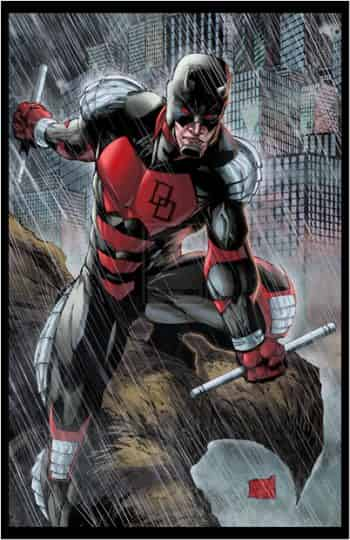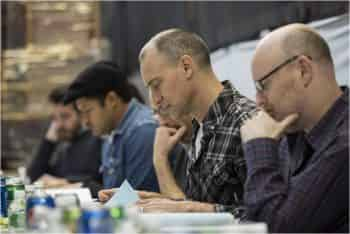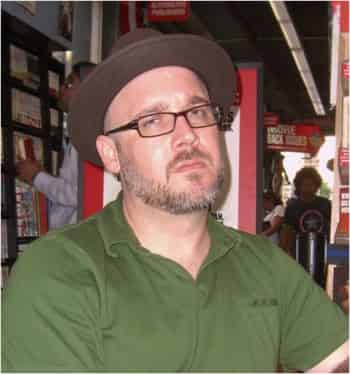
Rédaction
Sujet sérieux et traitement léger
En septembre 2011, Ed Campbell commenta le numéro de Catwomen qui comportait une case avec une connotation sexuelle très explicite entre l’héroïne et Batman (« Let’s Talk About Sex », www.comicbookdaily.com 30 septembre 2011). Campbell jugea la scène inappropriée pour une bande dessinée s’adressant à des adolescents. Durant quelques mois, plusieurs analystes commentèrent la situation, et certains d’entre eux jugèrent le contenu sexuel explicite comme étant une explication de la marginalisation de la bande dessinée américaine (« Sex & Violence », www.comicbookdaily.com, 9 décembre 2011).
Personnellement, nous ne partageons pas ce point de vue. C’est pour cela que nous ne privons pas nos aventures de scènes à caractère sexuel, nous estimons qu’elles deviennent du même souffle un moteur pour faire avancer les dimensions dramatiques de nos réceits. En contrepartie, nous pensons que nos aventures ne s’adressent pas à de jeunes adolescents, et ce, pas à cause de cette dimension sexuelle, mais plutôt à cause d’une certaine complexité narrative.
Par ailleurs, nous ne souhaitons pas que nos héroïnes se transforment en objet sexuel idéal (« Art and Superheroines: When Over Sexualization Kills the Story », www.comicsalliance.com, 16 février 2012).
La sexualité des personnages est une chose, mais le traitement de certains sujets peut prendre une drôle de tournure. Corey Schroeder dénonçait cette situation : « […] when Mockingbird was allegedly sexually assaulted by Phantom Rider, Hawkeye, her husband-to-be’s, reaction was to blame HER. You know, THE VICTIM. » (« Are Superhero Comics Too Serious », www.comicvine.com, 14 septembre 2011). Il y a des sujets qui mériteraient d’être traités avec un minimum de doigté. Il faut toutefois noter qu’un tel détachement peut devenir un excellent rebondissement dramatique dans le cas où on saurait en tirer toutes les implications.
Réflexion sur les vilains
Chris Sims dans l’un de ses commentaires (« Arcade and Why Success Doesn’t Make Vilain Credible », www.comicsalliance.com, 22 juin 2012) considère que le vilain est là pour faire obstacle au héros et, comme le héros doit triompher, les meilleurs vilains sont ceux qui déploient les obstacles les plus intéressants. Sara Lima offre un point des plus nuancé : elle considère que ce sont plutôt les interactions entre le héros et le vilain qui sont à prendre en considération (« What Makes a Good Comic Book Rivaltry? », www.comicvine.com, 5 avril 2012). Dans son commentaire, elle utilise le mot « Rivaltry (rivalité) ». Nous pensons, effectivement, que ce terme est plus approprié, car il ne prédétermine pas quelle partie doit triompher. Dans ce jeu de rivalité, certains personnages peuvent être amoraux. James Ellroy disait : « Le mal, ce sont les êtres sans conscience. Ceux qui sont incapables d’éprouver de la sympathie ou de l’empathie pour les autres êtres humains. » (« Le temps des moutons », extrait de Petite mécanique de James Ellroy, les éditions de L’œil d’or).
les personnages doivent-ils être considérés différemment selon leur sexe?
Sara Lima posait une excellente question : « How to Wrtite A Strong Female Character? (Comment écrire un personnage féminin fort?) » (« Greg Rucka on How to Wrtite A Strong Female Character », www.comicvine.com, 8 décembre 2011). Lors des premières phases de notre projet, il était évident que nous étions en présence d’un univers très masculin. Encore récemment, nous voyions que certaines aventures ne contenaient que des hommes. Pendant longtemps, nous avons hésité à développer des personnages féminins considérant que nous n’avions pas tout le bagage pour développer une psychologie féminine élaborée. Mais nous cherchions dans la mauvaise direction : ce ne sont pas des personnages féminins qu’il faut développer, mais des personnages forts qu’il faut créer. Nous disons fort dans le sens de complexe avec des zones de lumière et d’ombre, et des motivations avouées ou enfouies. Une fois ce constat fait, il n’y a plus de contrainte au processus créatif.
Arrêter la fuite en avant
Dans une critique sévère publiée il y a quelques mois, Graeme McMillan accusait quelques-uns des grands auteurs contemporains de bandes dessinées américaines d’être les responsables de la stagnation de l’industrie. Il affirmait : “« For an industry that feeds on its own past to go 20 years without fresh characters or concepts is death. The most telling sections in “Leaping Tall Buildings” are thus those written about industry powers like Brian Michael Bendis, Joe Quesada, Grant Morrison and Dan DiDio. » These are the men most responsible for the failure of the big publishers to take advantage of the public’s obvious fascination with men in capes.. (« The Four Men Who Have Destroyed the Superhero Comic Industry », www.newsarama.com, 30 mai 2012).
Est-ce un problème d’auteurs ou la volonté des éditeurs que de créer des événements. Nous considérons que Chris Sims pointe deux problèmes majeurs dans son analyse de l’évolution de la bande dessinée depuis les années 1990. D’abord, la montée en puissance des collections qui tend à mettre de la pression sur les numéros 1 d’une série indépendamment de son développement futur ou de ses qualités artistiques. Ensuite, les événements publicitaires s’avèrent contre-productifs. Sims prend en exemple la « mort » de Superman : « DC’s bright idea of « killing » Superman, which produced one of the best-selling comics of the modern era. In retrospect, it’s pretty clear to me that this was probably a terrible idea — and not just because it was a story where Superman and a giant bone monster in green bike shorts punched each other to death. It’s great that they sold a million comics and bought Dan Jurgens a solid gold statue of Booster Gold or whatever, but they also had a truly massive amount of media coverage that told people that Superman was dead, and lured them into a shop where they bought a comic that — if they bothered to actually pop open the polybag and read it — ended with Lois Lane cradling Superman’s lifeless body. In real life — in most fiction — that tends to be the end of things. They told the biggest potential audience they had ever had that Superman was dead. Dead. Which, to rational people who are not familiar with how comic books work, means « there will be no more Superman stories so it is completely unnecessary for you to ever return to this shop and buy another one of these. » », (« What’s Up With the 90s », www.comicsalliance.com, 27 juillet 2012).
Créer l’événement
Comme nous le disions dans un commentaire fait par le passé, les changements d’auteurs se veulent souvent une façon de relancer les ventes d’une série. L’auteur n’est pas toujours suffisant, il faut créer l’événement. Chichester l’admettait dans une entrevue dans laquelle il expliquait que le changement de costume de Daredevil au début des années 1990 se voulait une façon d’attirer l’attention des lecteurs sur la série et ainsi de positionner les autres changements de tons que l’on souhaitait introduire. (« Interview With D.G. Chichester (February 1998) », www.manwithoutfear.com).
Cependant, aujourd’hui, ces événements médiatiques deviennent souvent éculés. Tous les lecteurs savent bien que le décès d’un personnage principal n’est qu’une éclipse pour préparer son retour. Comme le dit Graeme McMillan : « It doesn’t help that it’s War in these teasers, a word that has similar weight at Marvel as “Crisis” does for DC. Between Secret War, Ultimate War, Civil War, Silent War, Chaos War and countless other wars that I’ve probably forgotten about (Oh! War of Kings, of course), the word has become almost meaningless in its attempt to suggest epic bombast, just like… Well, like the sight of Cap’s shield either cracked or splattered with blood, really. There’s an amazing sense of déjà vu from these trailers that’s unfortunate, especially considering that Avengers Vs. X-Men was already treading in “Haven’t I seen superheroes punching each other a lot recently in Civil War and X-Men: Schism?” waters. » (« I Don’t Wanna Live a War That’s Got Not End in Our Time », www.newsarama.com, 26 juin 2012).
La présence d’un « script editor »
Assurer la cohérence narrative est un grand défi. Principalement lors d’un changement d’auteurs. D’après nous, l’éditeur devrait avoir pour rôle d’assurer une transition harmonieuse, mais ce n’est pas le cas, car, le plus souvent, un nouvel auteur est l’occasion de relancer un titre, ce qui peut amener l’éditeur à accepter un changement de direction pas toujours élégant. Andrew Aardizzi émettait un commentaire très critique sur le travail de Mark Waid pour sa série Daredevil. D’après lui, l’auteur ferait table rase des plus récents événements et les dénierait même (« Episode 12: I Object! (to Mark Waid’s ‘Daredevil’) », www.comicbookdaily.com, 19 janvier 2012) .
La télévision offre une solution simple à un tel phénomène. Il est très rare qu’une série télé soit entièrement écrite par la même équipe d’auteurs. Un script editor verra à ce que les évolutions d’un auteur pour un épisode donné soient cohérentes avec la trame générale de la série.
Nous sommes actuellement dans la même situation. En effet, n’ayant pas assez de temps pour tout faire, nous avons préféré confier la rédaction des dialogues de certaines trames à un autre auteur. Nous veillons tout de même à vérifier son travail et à faire les ajustements nécessaires pour assurer la cohérence de notre récit.
Précisons que ce travail d’équipe à la rédaction est très enrichissant, car il permet de nombreux échanges, ce qui donne l’occasion d’approfondir notre réflexion sur les personnages.
La continuité n’empâche pas les transformations des personnages
Dans un commentaire précédent, traitant de la notion de continuité, nous citions un analyste qui souligne que les personnages principaux avaient souvent muté au point d’être méconnaissables. Scott VanderPloeg mentionnait à cet effet : « Batman can be a dark and gritty character, but can also be fun and light » (« What Happened? », www.comicbookdaily.com, 11 janvier 2012). Ce phénomène peut tenir au fait que les tendances sociales de l’époque devaient s’insérer progressivement dans le cours des histoires. Par contre, ce qui est plus déstabilisant, ce sont les brusques revirements de personnalité dus, le plus souvent, à une nouvelle équipe à la rédaction.
À ce sujet, plusieurs dénoncent que la continuité ne réside pas entièrement dans l’aventure en soi, mais dans l’équipe de rédaction. Graeme McMillan soulignait que « Better continuity developing through the line » (« Is Continuity Really a Draw for Superhero Universes? », www.newsarama.com, 26 juillet 2012). Ed Brubaker confia en entrevue qu’il était nostalgique de l’époque où un auteur et un dessinateur pouvaient collaborer sur des dizaines de numéros et ainsi avoir la latitude de développer des univers plus denses. (CR Sunday Interview: Ed Brubaker, www.comicsreporter.com, 24 juin 2012).
La continuité comme concept narratif théorique
Nous avons déjà mentionné dans nos dogmes la volonté de créer une continuité temporelle afin d’avoir une structure narrative pour soutenir la crédibilité de nos aventures. Le redémarrage des séries DC par la stratégie « New 52 » a donné lieu à des réflexions intéressantes sur différents blogues.
Graeme McMillan indique : « I really like the idea of continuity – that ongoing, collective narrative that can inform storytelling […] that ongoing, collective historical narrative that can inform storytelling » (« How Important is Continuity to You? », www.newsarama.com, 21 juin 2012).
Anthony Falcone, sur le même sujet, précise : « He [Kurt Busiek] also pointed out that even though Marvel has not had an official relaunch they basically are on their 4th era of comic books. Indeed for anyone only familiar with 1960s Marvel Universe many of the characters would be unrecognizable compared to their decade-of-love counterparts. ». Il tend à indiquer qu’un cycle cohérent d’aventures aurait une vingtaine d’années. Dépassait ce délai, les histoires perdraient une bonne partie de leur vraisemblance.
Ne pas perdre de vue les illustrateurs
Anthony Falcone se désolait que la montée en popularité des scénaristes semblait se faire au détriment des illustrateurs (« Artistes and Writers », www.comicbookdaily.com, 5 juin 2012). Nous sommes d’accord avec lui. Un auteur de bande dessinée n’est pas grand-chose s’il n’a pas un bon dessinateur pour traduire les ambiances qu’il souhaite créer dans ces histoires. Daniel Champion souligne une vérité simple au sujet de l’écriture d’une bande dessinée : « Use words AND picture to make a different statement, don’t use both to cover the same ground. » (« Writing for Comics », www.comicbookdaily.com, 18 juillet 2012). Matt Fraction mentionne que : « Comics are about that interplay, comics need that interplay to truly become more than the sum of its part » (Jeffery Klaehn, « Matt Fraction Interview », jefferyklaehn.blogspot.ca, 19 octobre 2011).
Encore Englehart et toujours Englehart
En analysant les volumes 4 et 5 des Essential Avengers, un critique écrivait : « in the big category, you get to watch the creators – particularly [Steve] Englehart – work out how modern comics were to be written, both the way that events took place in subplots that built to the next major crisis with one or two stories in between them… » (« CR Review: Essential Avengers, Vols. 4-5 », www.comicsreporter.com, 4 juin 2012). À une autre époque, nous avions déjà mentionné notre admiration pour le travail d’Englehart, car nous considérions que les aventures étaient constamment en progression et non pas entravées dans de profondes réflexions psychologiques ou dans des doutes existentiels.






